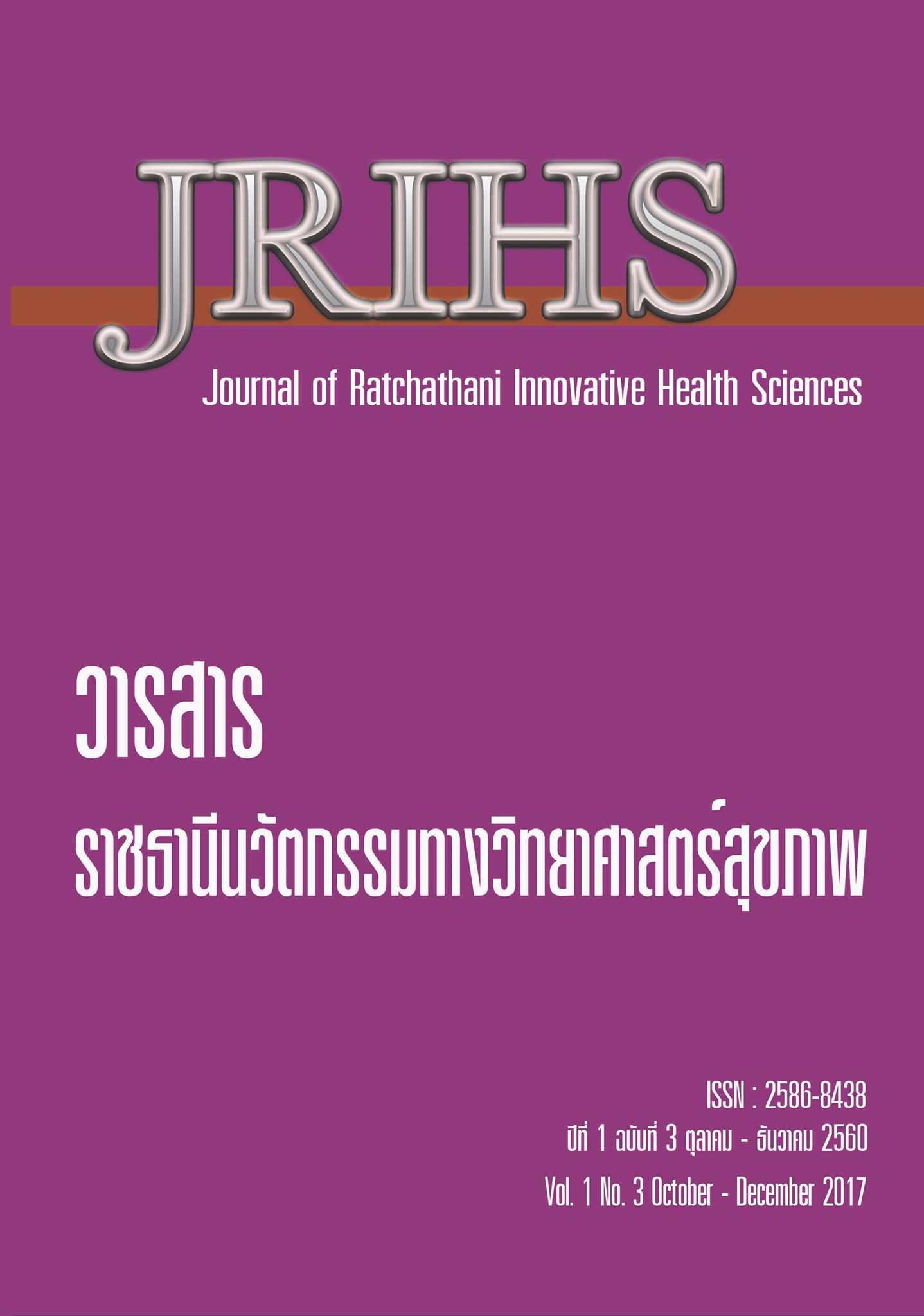The results of promoting a program of evidence-based practice in nursing practice for knowledge and the practice of nurses in acute pain management for the newborn
Main Article Content
Abstract
This research is preliminary experimental research (Pre-experiment research). Its purpose is to analyze the scope of knowledge that practical nurses have about the management of acute pain in the newborn before and after using the program. The study seeks to promote the use of evidence-based practice and study nurses’ opinion while using the program to promote the use of evidence-based practice. The sample used in this research was: 10 registered nurses who work in the children’s intensive care unit (children’s ICU) at Mukdahan hospital. Research tools consist of a program promoting the evidence-based practice in nursing practice for knowledge and the practice of nurses in acute pain management for the newborn and questionnaire with confidence value of 0.91. Statistics used in the research included percentage, average and standard deviation. Wilcoxon Match Paired Signed-Rank Test were also used.
The research results are as follows: The majority of registered nurses who are working in the children’s ICU have been employed for less than 10 years. The average was 7.5 years (60 percent). No experience in training for the pain management in the newborn (70 percent) and self-study or read the news about pain management in the newborn (80 percent). Registered nurses, who have been trained to use the program promoting the use of evidence-based practice, have higher knowledge scores (100 percent)
Registered nurses, who have been trained to use the program promoting the use of evidence-based practice, stated that the program is useful and should utilized to provide a guide for the use of an acute pain management in the newborn (80 percent)
Article Details
ความคิดเห็นและข้อเสนอแนะใดๆ ที่นำเสนอในบทความเป็นของผู้เขียนแต่เพียงผู้เดียว โดยบรรณาธิการ กองบรรณาธิการ และคณะกรรมการวารสารราชธานีนวัตกรรมทางวิทยาศาสตร์สุขภาพไม่ได้มีส่วนเกี่ยวข้องแต่อย่างใด มหาวิทยาลัยราชธานี บรรณาธิการ และกองบรรณาธิการจะไม่รับผิดชอบต่อข้อผิดพลาดหรือผลที่เกิดขึ้น จากการใช้ข้อมูลที่ปรากฏในวารสารฉบับนี้
References
ศาสตรมหาบัณฑิต สาขาการพยาบาลเด็ก, บัณฑิตวิทยาลัย, มหาวิทยาลัยขอนแก่น.
ขนิษฐา แช่มไล่ ลัพณา กิจรุ่งโรจน์ และวงจันทร์ เพชรพิเชฐเชียร. (2556). การพัฒนาแนวปฏิบัติการพยาบาลในการจัดการความปวดจากหัตถการในหอผู้ป่วยวิกฤตทางศัลยกรรม โรงพยาบาลสงขลานครินทร์. บทความวิจัยเสนอในการประชุมหาดใหญ่วิชาการ ครั้งที่ 4 วันที่ 10 พฤษภาคม 2556.
จรัสศรี เย็นบุตร,รุ่งทิพย์ คงแดง,วิลาวัณย์ พิเชียรเสถียร. (2550). ผลของโปรแกรมการส่งเสริมการใช้หลักฐานเชิงประจักษ์ต่อความรู้และการปฏิบัติของพยาบาลในการจัดการความปวดเฉียบพลันในทารกแรกเกิด. พยาบาลสาร ปีที่ 34 ฉบับที่ 3: 73-85.
ภากร ชูพินิจรอบคอบ. (2558). การพัฒนาและการใช้แนวปฏิบัติการพยาบาลตามหลักฐานเชิงประจักษ์ในการจัดการความปวดแบบเฉียบพลันของผู้ป่วยเด็กเล็ก. โครงการวิจัยเพื่อพัฒนางานของโรงพยาบาลธรรมศาสตร์เฉลิมพระเกียรติ หน่วยงาน งานการพยาบาลผู้ป่วยกุมารเวชกรรมสามัญ โรงพยาบาลธรรมศาสตร์เฉลิมพระเกียรติ ประจำปีงบประมาณ พ.ศ. 2558.
รุ่งนภา เขียวชะอุ่ม. (2556). การปฏิบัติการพยาบาลตามหลักฐานเชิงประจักษ์ Evidence-based Nursing. วารสารวิทยาลัยพยาบาลพระปกเกล้า จันทบุรี. 24(2). 94-108.
รุ่งทิพย์ คงแดง. (2550). ผลของโปรแกรมการส่งเสริมการใช้หลักฐานเชิงประจักษ์ต่อความรู้และการปฏิบัติของพยาบาลในการจัดการความปวดเฉียบพลันในทารกแรกเกิด. วิทยานิพนธ์พยาบาลศาสตรมหาบัณฑิต สาขาวิชาการพยาบาลเด็กบัณฑิตวิทยาลัย มหาวิทยาลัยเชียงใหม่.
เรณู พุกบุญมี. (2555). ผู้ปฏิบัติการพยาบาลขั้นสูงกับการปฏิบัติโดยใช้หลักฐานเชิงประจักษ์. ในสมจิต หนุเจริญกุล และอรสา พันธ์ภักดี. พิมพ์ครั้งที่ 2. กรุงเทพฯ. บริษัท จุดทอง จำกัด.
วิทยา เลิศวิริยะกุล. (2550). การระงับปวดในเด็ก (Pain management in infants and children). ในชัชชัย ปรีชาไว, อนงค์ ประสาธน์วนกิจ และวงจันทร์ เพชรพิเชษฐเชียร. ความปวดและการจัดการความปวดในกลุ่มผู้ป่วยที่มีปัญหาพิเศษ. (พิมพ์ครั้งที่ 1). สงขลา: ชานเมืองการพิมพ์.
ศนิชา เศรษฐ์ชัยยันต์. (2556). ประสิทธิผลของการพัฒนาแนวปฏิบัติทางคลินิกในการดูแลผู้ป่วยที่มีอาการปวดเฉียบพลัน. พุทธชินราชเวชสาร. 30(2), 198-207.
ส่องศรี หล้าป่าซาง. (2550). การพัฒนาและการใช้แนวปฏิบัติทางคลินิกสาหรับจัดการความปวดหลังการผ่าตัดในผู้ป่วยเด็ก. วิทยานิพนธ์หลักสูตรพยาบาลมหาบัณฑิตสาขาวิชาการพยาบาลกุมารเวชศาสตร์ มหาวิทยาลัยเชียงใหม่.
Anand, K. J. S. (1997). Long term effect of pain in neonatal and infants. In T.S.
Bontinx, F., Winkens, R., Grol, R., & Knotinerus, J. A.(1993).Influencing diagnostic and preventive performance in ambulatory care by feedback and reminders: A review. Family Practice, 10(2), 219-228.
Broom, M.E., Richistsmeier,A., Maikler,V.,& Aleander, M.A.(1996). Pediatric pain practices: A national survey of health professionals. Journal of Pain and Symptom Management, 11(5), 312-319.
Cassidy, K. L., Reid, G. J., McGrath, P. J., Finley, G. A., Smitth, D. J., Morley, C., et al. (2002). Watch needle, watch TV: Audiovisual distraction in preschool immunization. Pain Medicine, 3, 108-118.
Cohen, L.L., Blount, R.L., Cohen, R.J., Ball, C.M., McClellan, C.B., & Bernard, R.S. (2001). Children’s expectations and memories of acute distress: short-and long-term efficacy of pain management intervention. Journal of Pediatric Psychology, 26(6), 367-374.
Cromer, L.A., Hutsell, S., Latham, S.C., Bryant, K.G., Wacker, B.B., Smith, S.A. et al.(2004). Impact of implementing a method of feedback and accountability related to contact precaution compliance. American Journal of Infection Control, 32(8), 451-455.
Czarnecki, M. L., Turner, H. N., Collins, P. M., Doellman, D., Wrona, S., & Reynolds, J. (2011). Procedural pain management: A position statement with clinical practice recommendations. Pain Management Nursing, 12(2), 95-111.
Green LW, Kreuter MW. (1991). Health promotion planning: An educational and environment approach. California: Mayfield Publishing.
Gimbler-Berglund L., Ljusegren, G., & Enskar, K. (2008). Factors influencing pain management in children. Pediatric Nursing. 20(10), 21-24.
Harbarth, R., Pittet. D., Grady, L., Zawacki, A., Potter-Bynoe, G., Samore, M.H., et al.(2002). Intervention study to evaluate the impact of an alcohol-based hand gel in improving hand hygiene compliance. The Pediatric Infection Disease Journal, 21(6), 489-495.
Harrison, D., Loughnan, P., & Johnston, L., (2006). Pain assessment and procedural pain management practices in neonatal units in Australia. Journal of Pediatrics and Child Health, 42, 2006.
Kyle,T. & Carman, S. (2013). Essentials of pediatric nursing. (2nd ed.). Lippincott: Williams & Wilkins. Petovello, K. (2012). Pediatric Procedural Pain Management: A Review of the literature. International Journal of child, Youth and Family Studies, 4(1), 569-589.
Ljusegren, G. (2011). Nurses’ competence in pain management in children. University dissertation from Junkspin : School of Health Sciences.
Obrecht, J., & Andreoni, V. A. (2012). Pain management. In N. L. Potts & Barbara L.Mandleco. Pediatric nursing: Caring for children and their families, (3rd ed.). United State of America: Delmar cengage learning.
Petovello, K. (2012). Pediatric Procedural Pain Management: A Review of the literature. International Journal of child, Youth and Family Studies, 4(1), 569-589.
Pittet, D., Hugonnet, S., Harbarth, S., Mourouga, P., Suvan, V., Touveneau, S., et al.(2000). Effectiveness of a hospital-wide programme to improve compliance with hand hygiene. Infection Control Programme. Lancet, 356(9238), 1307-1312.
Polkki, T., Pietila, A.M., & Julkunen, V. (2003). Hospitalized children's descriptions of their experiences with postsurgical pain relieving methods. International Journal of Nursing Studies. 40(1). 33-44.
Silva, M. S., Pinto, M. A., Gomes, L. M. X., & Barbosa,T. L. de A. (2011). Pain in hospitalized children: nursing team perception. Revista Dor, 12(4), 314-320.
Tappen, M, R., Weiss, A. S., & White, K.D., (2004). Essentials of nursing leadership and management (3rd ed.) Philadelphia: F.A. Davis.
Twycross A. (2007). Children’s nurses’ post-operative pain management practices: an observational study. International Journal of Nursing Studies, 44(6), 869-881.
Vincent, C.V. & Denyes, M. J. (2004). Relieving children’s pain: nurses’ abilities andanalgesic administration practices. Journal of Pediatric Nursing, 19, 40-50.


